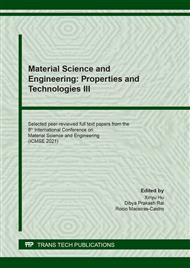[1]
N. S. Cohen, R. W. Fleming: Role of Binders in Solid Propellant Combustion. AIAA Journal, (1972).
Google Scholar
[2]
E. J. Vandenberg and F. Woods, U.S. Patent, 3,645,917. (1972).
Google Scholar
[3]
E. Kimura, Y. Oyumi: Thermal Decomposition of BAMO Copolymers. Propellants Explosives Pyrotechnics, 1995, 20: 322-326.
DOI: 10.1002/prep.19950200607
Google Scholar
[4]
H. Bazaki, N. Kubota: Energetics of AMMO. Propellants, Explosives, Pyrotechnics, 1991, 16 (2): 68-72.
DOI: 10.1002/prep.19910160206
Google Scholar
[5]
M. B. Frankel, L. R. Grant and J. E. Flanagan: Historical development of glycidyl azide polymer. Journal of Propulsion and Power, 1992, 8, 560-563.
DOI: 10.2514/3.23514
Google Scholar
[6]
Y.Q. Duo, H.M. Tan and F.T. Chen: Synthesis and characterization of thermoplastic polyurethanes as binder for novel thermoplastic propellant. Journal of Applied Polymer Science, 2002, 83(14), 2961-2966.
DOI: 10.1002/app.2350
Google Scholar
[7]
S.K. Manu, V. Sekkar, K.J. Scariah, T.L. Varghese and S. Mathew: Kinetics of glycidyl azide polymer-based urethane network formation. Journal of Applied Polymer Science, 2008, 110, 908-914.
DOI: 10.1002/app.28639
Google Scholar
[8]
S. Mathew, S.K. Manu and T.L. Varghese: Thermomechanical and Morphological Characteristics of Cross-Linked GAP and GAP–HTPB Networks with Different Diisocyanates. Propellants, Explosives, Pyrotechnics, 2008, 33, 146-152.
DOI: 10.1002/prep.200800213
Google Scholar
[9]
S. K. Reshmi, K. P. Vijayalakshmi, D. Thomas, E. Arunan, C. P. Reghunadhan and Nair: Glycidyl Azide Polymer Crosslinked Through Triazoles by Click Chemistry: Curing, Mechanical and Thermal Properties. Propellants Explosives Pyrotechnics, 2013, 38, 525-532.
DOI: 10.1002/prep.201200036
Google Scholar
[10]
B. S. Min, Y. C. Park and J. C. Yoo: A Study on the Triazole Crosslinked Polymeric Binder Based on Glycidyl Azide Polymer and Dipolarophile Curing Agents. Propellants, Explosives, Pyrotechnics, 2012, 37, 59-68.
DOI: 10.1002/prep.201000127
Google Scholar
[11]
Russell Reed and C. Jr. Ridgecrest,America Pat., (2000).
Google Scholar
[12]
C. Hu, X. Guo, Y. Jing, J. Chen, C. Zhang and J. Huang: Structure and mechanical properties of crosslinked glycidyl azide polymers via click chemistry as potential binder of solid propellant. Journal of Applied Polymer Science, 2014, 131(16), 40636.
DOI: 10.1002/app.40636
Google Scholar
[13]
T. Keicher, W. Kuglstatter, S. Eisele, T. Wetzel and H. Krause: Isocyanate-Free Curing of Glycidyl Azide Polymer (GAP) with Bis-Propargyl-Succinate (II). Propellants, Explosives, Pyrotechnics, 2009, 34, 210-217.
DOI: 10.1002/prep.200900001
Google Scholar
[14]
F. Liu, X. Zhang, W. Jiang, F. Yu and J. Deng: Study on the Curing System of Polytriazole Adhesive for Composite Solid Propellant. Propellants, Explosives, Pyrotechnics, 2018, 43, 371-378.
DOI: 10.1002/prep.201700280
Google Scholar
[15]
S. K. Reshmi, K. P. Vijayalakshmi, D. Thomas, E. Arunan and C. P. R. Nair: Glycidyl Azide Polymer Crosslinked Through Triazoles by Click Chemistry: Curing, Mechanical and Thermal Properties. Propellants, Explosives, Pyrotechnics, 2013, 38, 525-532.
DOI: 10.1002/prep.201200036
Google Scholar
[16]
S.H. Sonawane, M. Anniyappan, J. Athar, S. Banerjee and A. K. Sikder: Synthesis of bis(propargyl) aromatic esters and ethers: a potential replacement for isocyanate based curators. RSC Advances, 2016, 6, 8495-8502.
DOI: 10.1039/c5ra25909f
Google Scholar
[17]
K. Menke, T. Heintz, W. Schweikert, T. Keicher and H. Krause: Formulation and Properties of ADN/GAP Propellants. Propellants Explosives Pyrotechnics, 2010, 34, 218-230.
DOI: 10.1002/prep.200900013
Google Scholar
[18]
W. Dannhauser, Polymers: chemistry and physics of modern materials. (1974).
Google Scholar
[19]
A. A. Accurso, M. Delaney, J.Brien, H. Kim, P. M. Iovine, D. D. Diaz, and M. G. Finn: Improved Metal-Adhesive Polymers from Copper(I)-Catalyzed Azide–Alkyne Cycloaddition. Chemistry - A European Journal, 2014, 20:10710-10719.
DOI: 10.1002/chem.201400137
Google Scholar


